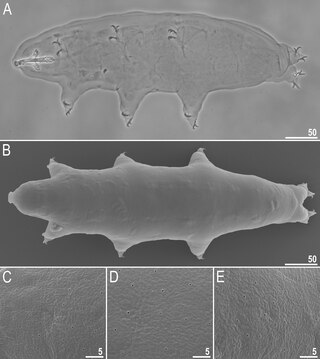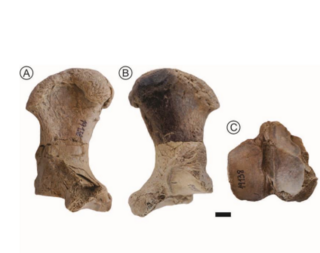
Eutardigrada are a class of tardigrades (Tardigrada) without lateral appendages. Primarily freshwater bound, some species have secondarily gained the ability to live in marine environments (Halobiotus). By cryptobiosis many species are able to live temporarily in very dry environments. More than 700 species have been described.

Hypsibius dujardini sensu lato is a species complex of tardigrade in the class Eutardigrada. A member of this complex, Hypsibius exemplaris, is widely used for various research projects pertaining to evolutionary biology and astrobiology.

Echiniscus testudo is a cosmopolitan species of tardigrade.

Hypsibius is a genus of tardigrades in the class Eutardigrada.

Ramazzottius is a genus of water bear or moss piglet, a tardigrade in the class Eutardigrada.

Itaquascon is a genus of tardigrade in the class Eutardigrada.

Milnesium is a genus of tardigrades. It is rather common, being found in a wide variety of habitats across the world. It has a fossil record extending back to the Cretaceous, the oldest species found so far is known from Turonian stage deposits on the east coast of the United States. Milnesiums are one of the most desiccation and radiation-resistant invertebrates on Earth because of their unique ability to transform into a "tun" state and utilize intrinsically disordered proteins when experiencing extreme environments.
Milnesium antarcticum is a species of Eutardigrades in the family Milnesiidae. This species differs from its cogenerate species mainly by proportions of its claws and buccopharyngeal apparatus.
Milnesium almatyense is a species of Eutardigrades in the family Milnesiidae. This species differs from its cogenerate species mainly by proportions of its claws and buccopharyngeal apparatus.
Milnesium asiaticum is a species of Eutardigrades in the family Milnesiidae. This species differs from its cogenerate species mainly by proportions of its claws and buccopharyngeal apparatus.
Milnesium reductum is a species of Eutardigrades discovered by zoologist Denis. V. Tumanov in 2006. This species of Tardigrade is part of the family Milnesiidae. This species differs from its cogenerate species mainly by proportions of its claws and buccopharyngeal apparatus.
Milnesium longiungue is a species of Eutardigrades in the family Milnesiidae. This species differs from its cogenerate species mainly by proportions of its claws and buccopharyngeal apparatus.

Echiniscus is a genus of tardigrades in the family Echiniscidae. The genus was named and described by Karl August Sigismund Schultze in 1840.
Macrobiotidae is a family of tardigrade. As of 2023, it consists of the following genera:

Macrobiotus shonaicus is a species of tardigrade in the family Macrobiotidae. As of 2018 it is only known from its type locality: Tsuruoka, Japan. The species description was published in 2018. The insides of their first three pairs of legs have a slight fold above their claws, and their eggs have processes whose terminal discs split off into thin filaments.
Echiniscus madonnae is a tardigrade species, genus of Echiniscus. It was described by Polish zoologists Michalczyk and Kaczmarek Łukasz in South America in 2006, and named in honor of American singer-songwriter Madonna.

Megatheriinae is a subfamily of the Megatheriidae, an extinct family of ground sloths that lived from the Middle Miocene to the Early Holocene.

Prepoplanops is an extinct genus of ground sloth of the family Megatheriidae. It lived in the Miocene around 18 to 16 million years ago of what is now Argentina. The only known species is Prepoplanops boleadorensis.

Milnesium alpigenum is a species of tardigrade that falls under the Tardigrada phylum. Like its taxonomic relatives it is an omnivorous predator that feeds on other small organisms, such as algae, rotifers, and nematodes. M. alpigenum was discovered by Christian Gottfried Ehrenberg in 1853. It is very closely related to Milnesium tardigradum along with many other species from the Milnesium genus.
Mesobiotus is a genus of tardigrades belonging to the family Macrobiotidae.











